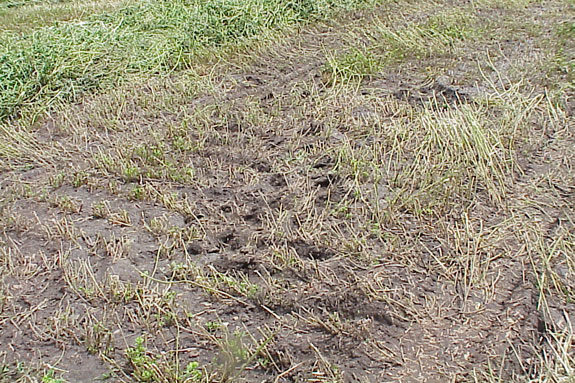Maintaining high-yielding, persistent alfalfa stands can be challenging, particularly when soils are limited by imperfect drainage or compaction.
University of Wisconsin research showed that wheel traffic damage from normal harvesting operations can cause alfalfa yield reductions as high as 80 percent. The amount of damage was related to the length of time regrowth occurred before driving on the alfalfa.
More recent research from Wisconsin showed a 4 to 6 percent reduction in alfalfa yield when alfalfa was driven on after one day of mowing, whereas wheel traffic at five days had an average yield penalty of 20 percent.
The reduction in yield was attributed to damaged and/or broken crowns caused by tractor wheels (e.g., a100 HP tractor was driven over alfalfa four times). It is estimated that about 70 percent of a field’s area is driven over at each cutting, so avoiding unnecessary trips across the field is key to minimize wheel traffic damage.
Soil compaction from tractors and manure spreaders also reduces alfalfa productivity and persistence. Compacted soil reduces pore space and hinders fine root growth. All else equal, compaction potential increases with soil wetness and clay content.
Lower field areas are usually more imperfectly drained due to their landscape position – they collect surface water and have water tables closer to the soil surface. These lower areas of the landscape also tend to have greater silt and/or clay contents compared to higher landscape positions, which makes them even more susceptible to compaction damage.
Consider the following five management practices to help minimize alfalfa damage caused by wheel traffic and compaction:
1. Harvest as quickly as possible after mowing (utilizing wide swaths to speed up drydown) to avoid traveling on alfalfa regrowth.
2. If applying manure, apply it as soon as possible following harvest, always before regrowth, and avoid spreading on wet fields.
3. Utilize controlled traffic patterns to minimize the field area traveled on. For example, utilize the same area of the field to the extent possible when entering and exiting the field with trucks or forage wagons during harvest.
4. Consider planting traffic-tolerant alfalfa varieties.
5. Avoid using dual-wheel tractors on alfalfa fields and try to utilize lighter-weight tractors when merging, raking, etc. FG
References omitted but available upon request.
Eric Young
Agronomist/Soil Scientist
William H Miner Agricultural Research Institute
—From The William H Miner Agricultural Research Institute's Farm Report
PHOTO
Photo by Scott R. Hendrickson.











